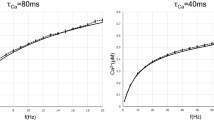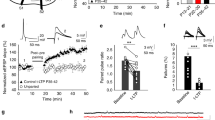Abstract
IN the hippocampus and neocortex, high-frequency (tetanic) stimu-lation of an afferent pathway leads to long-term potentiation (LTP) of synaptic transmission1–5. In the hippocampus it has recently been shown that long-term depression (LTD) of excitatory transmission can also be induced by certain combinations of synaptic activation6,7. In most hippocampal8 and all neocortical pathways4,9–11 studied so far, the induction of LTP requires the activation of JV-methyl-D-aspartate (NMDA) receptorgated conductances. Here we report that LTD can occur in neurons of slices of the rat visual cortex and that the same tetanic stimulation can induce either LTP or LTD depending on the level of depolarization of the postsynaptic neuron. By applying intracellular current injections or pharmacological disinhibition to modify the depolarizing response of the postsynaptic neuron to tetanic stimulation, we show that the mechanisms of induction of LTD and LTP are both postsynaptic. LTD is obtained if postsynaptic depolarization exceeds a critical level but remains below a threshold related to NMDA receptorgated conductances, whereas LTP is induced if this second threshold is reached.
This is a preview of subscription content, access via your institution
Access options
Subscribe to this journal
Receive 51 print issues and online access
$199.00 per year
only $3.90 per issue
Buy this article
- Purchase on SpringerLink
- Instant access to full article PDF
Prices may be subject to local taxes which are calculated during checkout
Similar content being viewed by others
References
Bliss, T. V. P. & Lomo, T. J. Physiol. Lond. 232, 331–356 (1973).
Komatsu, Y., Toyama, K., Maeda, J. & Sakaguchi, H. Neurosci. Lett. 26, 269–274 (1981).
Lee, K. S. Brain Res. 239, 617–623 (1982).
Artola, A. & Singer, W. Nature 330, 649–652 (1987).
Perkins, A. T. & Teyler, T. J. Brain Res. 439, 222–229 (1988).
Stanton, P. K. & Sejnowski, T. J. Nature 339, 215–218 (1989).
Staubli, U. & Lynch, G. Neurosci. Abstr. 225, 16 (1988).
Collingridge, G. L., Kehl, S. J. & McLennan, H. J. Physiol., Lond. 334, 33–46 (1983).
Sutor, B. & Hablitz, J. J. Neurosci. Lett. 97, 111–117 (1989).
Kimura, F., Nishigori, A., Shirokawa, T. & Tsumoto, T. J. Physiol., Lond. 414, 125–144 (1989).
Artola, A. & Singer, W. Eur. J. Neurosci. 2, 254–269 (1990).
Chagnac-Amitai, Y. & Connors, B. W. J. Neurophysiol. 61, 747–758 (1989).
Wigström, H. & Gustafsson, B. Nature 301, 603–604 (1983).
Larson, J. & Lynch, G. Science 232, 985–988 (1986).
Reiter, H. O. & Stryker, M. P. Proc. natn. Acad. Sci. U.S.A. 85, 3623–3627 (1988).
Bear, M. F., Kleinschmidt, A., Gu, Q. & Singer, W. J. Neurosci. 10, 909–925 (1990).
Bienenstock, E. L., Cooper, L. N. & Munro, P. W. J. Neurosci. 2, 32–48 (1982).
Bear, M. F., Cooper, L. N. & Ebner, F. F. Science 237, 42–48 (1987).
Author information
Authors and Affiliations
Rights and permissions
About this article
Cite this article
Artola, A., Bröcher, S. & Singer, W. Different voltage-dependent thresholds for inducing long-term depression and long-term potentiation in slices of rat visual cortex. Nature 347, 69–72 (1990). https://doi.org/10.1038/347069a0
Received:
Accepted:
Issue Date:
DOI: https://doi.org/10.1038/347069a0



